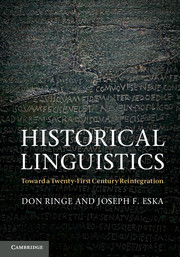Book contents
- Frontmatter
- Contents
- Figures
- Tables
- Preface
- Acknowledgments
- Introduction
- 1 The nature of human language and language variation
- 2 Language replication and language change
- 3 Language change in the speech community
- 4 Language contact as a source of change
- 5 Sound change
- 6 The evolution of phonological rules
- 7 Morphology
- 8 Morphological change
- 9 Syntactic change
- 10 Reconstruction
- 11 Beyond comparative reconstruction
- Appendix: Recovering the pronunciation of dead languages: types of evidence
- References
- General index
- Index of languages and families
4 - Language contact as a source of change
Published online by Cambridge University Press: 05 February 2013
- Frontmatter
- Contents
- Figures
- Tables
- Preface
- Acknowledgments
- Introduction
- 1 The nature of human language and language variation
- 2 Language replication and language change
- 3 Language change in the speech community
- 4 Language contact as a source of change
- 5 Sound change
- 6 The evolution of phonological rules
- 7 Morphology
- 8 Morphological change
- 9 Syntactic change
- 10 Reconstruction
- 11 Beyond comparative reconstruction
- Appendix: Recovering the pronunciation of dead languages: types of evidence
- References
- General index
- Index of languages and families
Summary
Dialect contact and language contact
We have seen that linguistic innovations spread from dialect to dialect by borrowing in contact situations. While it seems clear that the innovations are often reanalyzed, so that the borrowing is not “perfect,” it appears that linguistic material of any kind can be borrowed from one dialect into a mutually intelligible dialect. This chapter will address contact between dialects that are not mutually intelligible – that is, between different languages. Of course such a distinction is merely practical: dialects of a single language can differ from each other in all and only the ways in which obviously different languages can differ, and there is no sharp boundary between “dialect differences” and “language differences” – there is a cline of intermediate cases. But the practical consequences of this practical distinction are important: borrowing of linguistic structure into one's native dialect from a mutually unintelligible speechform is clearly much harder than borrowing from a readily intelligible dialect, and the circumstances in which it is possible at all remain a subject of debate.
To address this problem coherently we need to make several conceptual distinctions of fundamental importance. On a purely linguistic level we distinguish between lexical material and structural material; the latter includes all morphosyntax, i.e. syntactic structure and those items dominated by “functional heads,” such as Tense. On the cognitive level we distinguish between monolingual speakers, who speak only one language with any facility (though they may control a range of its dialects), and bilingual (including multilingual) speakers, since it seems likely a priori that they behave differently and since bilingualism can be viewed as language contact of a special kind, within the individual rather than within the community. We also need to distinguish between individuals who are natively bilingual and those who have learned a second language imperfectly in adulthood, after the critical period for native language acquisition has closed. Finally, we distinguish between importation of linguistic material into one's native dialect, which we refer to as “borrowing,” and importation of material from one's native dialect into a second language learned imperfectly in adulthood, which we refer to as “interference.” This last distinction was first clearly articulated by Thomason and Kaufman 1988: 37–45 and van Coetsem 1988: 2–3. We will use “transfer” as a cover term for borrowing and interference.
- Type
- Chapter
- Information
- Historical LinguisticsToward a Twenty-First Century Reintegration, pp. 59 - 77Publisher: Cambridge University PressPrint publication year: 2013



